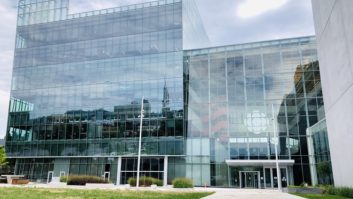CBC/Radio-Canada’s French Radio Service Upgrades Facilities
Nov 1, 2010 3:00 PM, By Roger Maycock
Transition to a fully digital infrastructure enables centralized network operations

CBC/Radio-Canada”s Studio 17
Determined to increase operating efficiencies by having a more advanced means of gathering and managing program material from multiple sources located throughout Canada, CBC/Radio-Canada’s French Radio Service (Radio de Radio-Canada) has reached a lofty milestone in its multi-year plan to enhance its facilities. In July, the Montreal broadcast operations center completed a major phase that dramatically upgraded the radio master control center, including the replacement of a legacy analog switcher that had maxed out its capacity and had no provisions for expansion. Following an extensive evaluation of its facilities and operations, determining a course of action that would allow for future growth, and completing contract negotiations, a new central audio router and control system for all of Radio-Canada’s radio production and distribution was put into service.
The Toronto office of Rastatt, Germany-headquartered Lawo, known for its digital audio networking and console systems, was awarded the contract to deploy a system incorporating its router and audio networking technologies in conjunction with VSM (Virtual Studio Manager) control software. Radio-Canada’s new system includes the Lawo DSHS (Dual Self-Healing Star) router configuration with two fully redundant Nova 73 router cores � one located in the radio master equipment room and the other in the TV master equipment room. Each router is equipped with 54 MADI ports, three DSP boards that process 184 signals each, and 19 Lawo Dallis frames for input/output.
Michel Leduc, broadcast engineering manager for CBC/Radio-Canada’s French Services, commented on the extent of the facility upgrade, “We were aware of several new projects on the horizon that required greater switcher capacity, so the necessity of upgrading our broadcast center was vital. We were looking for state-of-the-art technology that offered expansion, reliability, along with the possibility of having control and DSP capabilities.”
Routing provisions

Studio 17 control room
The Lawo DSHS routing system utilizes a de-centralized architecture that literally spans all areas of the Montreal broadcast complex. For full system redundancy, each Dallis frame is connected to both Nova 73 HD cores. The DSHS system utilizes a special application for the Nova 73 router whereby all potential single points of failure � including the rack and room where the main frames reside � are doubled. A link between the two cores ensures that if the radio core fails, the TV core will assume responsibilities. Of equal significance, if any partial failure occurs, the alternate core can assume those functions while the remaining tasks are managed by the partially impaired core.
Support for existing hardware was deemed crucial to enable the project to move forward in phases � thus enabling Radio de Radio-Canada to better manage the revitalization process from both operational and financial perspectives. “We have a number of existing Pro-Bel HD series MADI frames and Studer mixing consoles that remain operational,” Leduc says. “The old Pro-Bel switcher is based on MADI communication between the I/Os and the core. To avoid replacing all the existing analog feeds, the MADI feeds are tied to the Lawo core. This arrangement enables us to continue using the existing analog feeds and helps CBC/Radio-Canada make the transition to a fully digital infrastructure while maintaining interim support for legacy hardware. Equally important, this setup helps us control our costs.”
Software control

A temporary control room will be used until additional renovations occur. Completion is expected in December 2010.
Managing the new signal routing capabilities is a VSM-based application jointly developed by Lawo and Radio-Canada personnel with a significant amount of support from Bingen-Germany-based L-S-B Broadcast Technologies, the developers of Virtual Studio Manager. Encompassing more than 34 PC-based stations with a combination of virtual panels, custom designed touch screens, or mouse control panels, the software provides a highly integrated control and management system for Radio de Radio-Canada’s MCR (master control room) operation. On any two independent workstations, two operators can handle the entire system. “Our other key challenge with this project,” Leduc says, “was to develop an easy to use GUI (graphical user interface) that offered the necessary amount of alarms and other features to facilitate our present and future on-air radio operations.”
Jean-Marc Gellatly, director of production studio radio and radio operations at Radio de Radio-Canada, commented on the considerable technological leap this represents, “We knew that today’s cutting-edge technology would allow us to completely rethink how the MCRs of the future would be managed and operated and, with this implementation, we are positioned to maximize radio’s role in a completely integrated content company.”
The Radio-Canada/Lawo-designed VSM software includes provisions for metering upward of 72 stereo streams as well as automatic multilayer apology, fading, alarm logging and processing for more than 150 on-air busses. The system incorporates Avocent 5010 KVM management (a switcher system for assigning control functions to any of the 100+ various computer stream/keyboard/mouse stations) and offers sophisticated XY control of 4,000 � 4,000 mono signals � the new system’s present capacity. Additionally, the VSM software provides integrated alarm monitoring and logging for all Lawo components. Depending upon the actual screen/function an operator is working on, the VSM system provides tremendous flexibility in tracking all source and destination signal routing, the ability to view color-coded alarm displays for managing the status of all automated output busses, along with processing panels to address alarm conditions, plus numerous other functions.
—Continued on page 2
CBC/Radio-Canada’s French Radio Service Upgrades Facilities
Nov 1, 2010 3:00 PM, By Roger Maycock
Transition to a fully digital infrastructure enables centralized network operations

The Pro-Bel I/O in the radio equipment room
Radio de Radio-Canada’s new Lawo/VSM system also supports extensive remote access provisions. “The entire MCR is a virtual setup,” Leduc explains. “Via IP protocol, the system can be controlled with ease from any place in the world and, as one would expect, includes an elaborate system of protection and security mechanisms. With full remote access to the system in the event of a crisis, operators have the ability to patch into the network and run everything remotely should the occasion ever arise � making our radio operations more secure than ever.”
Actual on-air feeds are handled by Radio de Radio-Canada’s Harris 8200 Series automation system. “Interfacing with our Harris system was another crucial aspect of this project,” Leduc says. “Here too, the combination Lawo/VSM setup manages production and routing feeds for all content going through the Harris system and includes stop fades or V fades of signals for smooth signal transition. The VSM supports integration for apology and router control, and enables our existing radio consoles to control the router directly.”
An eye on the future

The Lawo core in the radio equipment room
CBC/Radio-Canada’s French Radio Service is now in the process of expanding the system by 18 more Dallis frames and additional buses. In August, another 14 on-air output busses were added and an additional expansion phase will add roughly another 44 on-air output buses in 2011.
“We are extremely optimistic about the opportunities the new combination Lawo/VSM system provides,” Leduc says. “The new Lawo router control system replaces our aging, analog master control room infrastructure, including a massive patchbay that consisted of approximately 11,000 patch points that were being handled manually, with a much more efficient system that offers the ability to grow as our requirements evolve.”

The Harris, Dalet, VSM, Avocent systems in the TV equipment room.
“The new system airs all of the programming for Radio-Canada’s Premi�re Cha�ne, including its top-rated morning show “C’est bien meilleur le matin” (“It’s better in the morning”) as well as its entire sister Network Espace musique’s programming. While there remains much to do, our new equipment is already providing return on investment. Though we are presently in a temporary control room setup as additional renovations are being made, I fully expect the new system to dramatically increase operating efficiencies. I’m really looking forward to December when the bulk of the renovation and construction will be completed and we can settle into our newly upgraded facilities. With the integration of our existing consoles and studios, our new setup provides decentralized access to any signal throughout our complex, and this provides increased functionality and efficiency throughout the entire CBC/Radio-Canada system.”

VSM Alarm Status Panel

VSM XY Panel

VSM Alarm Processing Panel
Equipment list
VSM (Virtual Studio Manager) control software: VSM Control GmbH (L-S-B Broadcast Technologies)
Lawo Nova 73 HD router x 2 with Dual Self-Healing Star topology, 3 DSP cards and 19 Dallis I/O cards
Pro-Bel HD series MADI System 3 Controller x 1
Avocent 5010 KVM management system x 6
Studer model 963 analog console x 5
Studer On Air 2000 digital console x 5
Studer On Air 3000 digital console x 5
Harris 8200 Series Automation System with two master servers and three pairs of device automation
Maycock is the owner of Mountaincrest Communications, Downey, CA.
November 2010
Choosing a computer audio interface, a tour of the CBC/Radio-Canada’s upgrade, multimedia for digital radio, calculating STL fade margin and more….











